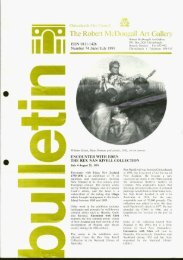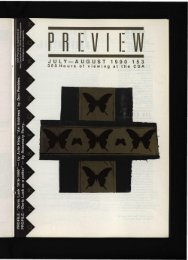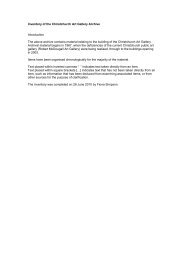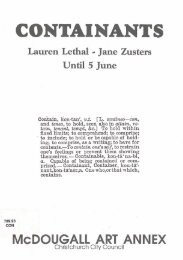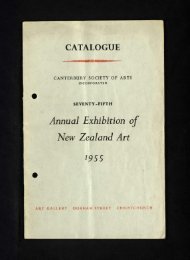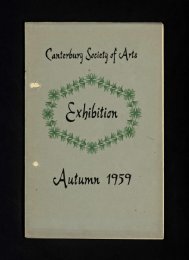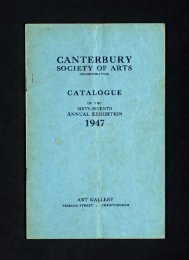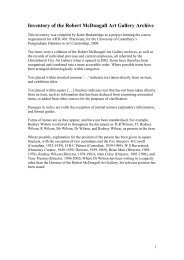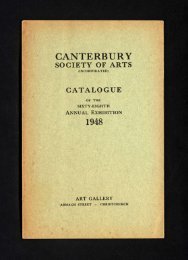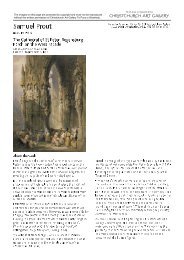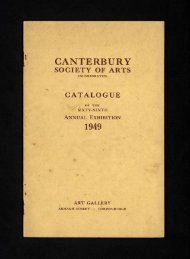Download (8.9 MB) - Christchurch Art Gallery
Download (8.9 MB) - Christchurch Art Gallery
Download (8.9 MB) - Christchurch Art Gallery
- No tags were found...
You also want an ePaper? Increase the reach of your titles
YUMPU automatically turns print PDFs into web optimized ePapers that Google loves.
sculptural form and deep rich colours, but as time progressed,I was increasingly drawn to "La Coiffure", which demandedmore participation in the discovery of subtle innuendosin the positive and negative areas and colour relations,enjoyment of which replaced the narrative.Picasso was also represented by several superb drawings.Three line drawings of nudes draped on a beach had suchsurprising clarity of execution, incredible liberties in thecontours as to create statuesque forms of great beauty,reminiscent of classical composure. One couldn't help butfeel in the presence of a master.Five Bonnard paintings were exhibited, tantalising the viewerwith colour that glowed like jewels, particularly in "Morning inthe Garden", where I found I became involved with the moreabstract and painterly qualities than with the rather mysteriousscene. Rich, sensuous glowing colour harmoniestypified all the Bonnards.Three Nudes reclining on a beachby PicassoMatisse was represented by three paintings. "Nasturtiumsand the Dance" impressed partly due to scale, but its glowinglively colours and simplified forms, uncluttered space, suchease in the manipulation of paint, contributed to the sensationof elegance and honesty.Juan Gris" painted by Modigliani, though relatively a smallwork, became a living presence for me in the exhibition. Thesubdued but intense colours, the form and tilt of the head andneck, langorous eyes, the depth I hadn't expected fromseeing reproductions.Chaim Soutine's painting of "Madeleine Castaing" was unexpectedin the restraint of brushwork and paint application,though the beauty of the combination of the particular blue,black and red was marvellous, not nearly as "tormented" as Ibelieved it would be.There were several drawings and paintings by Paul Klee, fullof wit and mysticism, as in the drawings "Episode before anArab town", and "Ghost Chamber with tall door", but "OrientalGarden" and "Colourful architecture" were paintingstypically modest in size, that were real gems. No reproductionthat I have seen has done them justice! Paint appliedwith such delicacy and devotion, colours that sparkled.Stuart Davis's painting, "Edison Mazda" had a space andlight not apparent in the catalogue illustration, and by thecareful choice of a few simple objects, flattening shapes byoutlining them, and patterning, this painting displayed muchwit.Willem de Kooning was represented by one very vibrantlycoloured painting titled "Seated Woman" in which the brightcoloured areas dominated the forms, with a noticeableamount of drawing over and under the painted areas; andtwo paintings very much more subdued colourwise of "Twomen standing", and "The Glazier". With time, these becamea more dominating presence in the exhibition, their ratherweird, but fascinating forms, creating a curious ambiguity.A triptych titled "The beginning", by Max Beckman, initiatedmuch contemplation, packed with imagery, rather dauntingat first sight, one gradually sifts through the symbolism to aninterpretation identifiable with one's own life. Marvellouspassages of colour enriched the experience and added tothe mystical rather claustrophobic feeling due to the obviousrestraints impinged upon the characters in the crowdedspace, but it also suggested that by the exercising of theimagination and creative activities, freedom and escapefrom the bonds imposed by society was possible.Likewise, though in a different vein, James Ensor's painting"The banquet of the Starved", with rather repellant imageryof grotesque "Punch and Judy" like characters, held afascination in the discovery of contrasts between the sicklyimagery and the soft clear colours, the strange but beautifullypainted creatures on the meal table, the wit in the stances ofthe cavorting skeletons in the background, and the parallelbetween the characters around the table to forms of humanbehaviour that are all too familiar.Giorgio de Chirico's "Self portrait", an unusual profile viewdemanded contemplation, as did Jacque Villon's "The diningtable" with its lines connecting objects and spaces in anintriguing cubistic manner. "Table on a cafe terrace" byDiego Rivera, again with its cubistic devices and pointfilliststrokes, came to life seeing it first hand.Of the three sculptures in the exhibition, the one by IsamuNoguchi, a Japanese-American, titled "Kouros" from theGreek meaning simply, image of man, constructed in thinpink marble slabs with rounded contours, creating such adelicate and precise balance, that it invoked strong feelingsof the precariousness of life. A very beautiful sculptural form.Of the seventy-three works in this exhibition I have onlyKourosby Isamu Noguchidiscussed those works that I found most meaningful. Thereare other 20th century masters that confrontation with theoriginal works would have a profoundly beneficial effect, infact as a practising artist, is a necessary and extremelyenriching experience, as the most powerful feeling whichbecame increasingly apparent viewing this exhibition plussome of the work in the Sydney Biennale and other gallerieswas the love, devotion, innovation, commitment, sincerityand conviction, with which the works were executed. Sadlyonly one woman was included, Georgia O'Keefe.A general observation:Two surprising things in public and dealer galleries in Australia:(1) The number of women represented was very low;(2) There was a surprising ignorance of artists in NewZealand.



